The "FLG" type of installation always generates the longest service life and can be operated with the max. values for speed and acceleration.
Unsupported - short travel
If the upper run of the E-Chain® operates without touching the lower run over the entire travel, it is called an "unsupported" application.
That is the distance between the moving end and start of radius bend of the E-Chain®. The unsupported length is always dependent on the chain type and the fill weight.
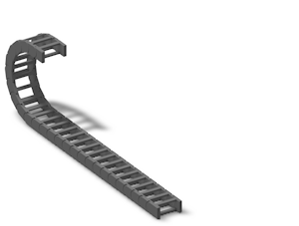
Example for unsupported straight FLG


The unsupported application is the most common of all application types. igus® E-Chain® systems are ideally suited for high dynamics and long service life. The maximum unsupported length is dependent upon the fill weight and the type of E-Chain® or E-Tube. As a result, we differentiate among three types of unsupported length:
The e-chain® is in the FLG range, if its upper run either has pretension still, is straight, or has a maximum sag of half the height of a chain link. The "FLG" type of installation is always preferred. The e-chain® runs quietly and is not exposed to any additional vibration.
The e-chain® is in the FLB range, if its sag is more than half the height of chain and less than the smallest available radius in the chain series. The "FLB" application is technically permissible in many cases. However, there are limitations in the maximum speed and acceleration.
If the sag is higher than the admissible FLB, then we speak of a critical sag. An installation with critical sag must be avoided, or be subjected to special solutions. An e-chain® should never be installed with critical sag. There are applications which, after a very long period of use, reach the stage of "critical sag." The e-chain® or E-Tube should be replaced at that time. In such cases, please contact us!

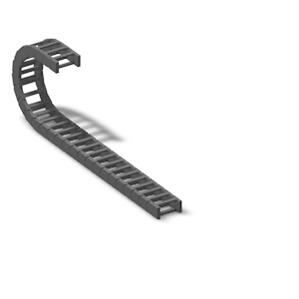
Example for unsupported with curve FLB
For every igus® E-Chain® or ETube, you will find the values for "FLG" and "FLB" in two locations: On the following pages in this chapter as an overview and within every individual series’ chapter. These values are essential for:
Finding a suitable E- Chain® for your fill weight and travel distance
Identifying the maximum load for the selected E-Chain®
Unsupported Length
Speed
Acceleration
Service life
Load bearing areas
Noise level
Technical environment
If your application, fill weight and travel fall outside the "unsupported length" parameters of the desired E-Chain®, you have the following options:
Select a more stable igus® E-Chain®
Support the E-Chain® in the unsupported area (this possibility has restrictions for acceleration, speed and noise as a consequence. Three fundamental examples are detailed to below. Please consult igus® if you are considering this possibility. We will gladly provide you with a detailed proposal
Use a "multiband" chain or "nest" two E-Chains® inside one another. (Please consult igus® regarding these options)
Design the travel distance as a "gliding application".
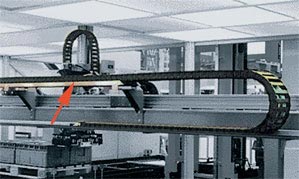
Series 28 with support of the "FLB" area

Support of the "FLG" area. The overall "straight, unsupported travel" can be increased along the upper run by a maximum of 50% of the FLG and along the lower run by a maximum of 100%

Support of the "FLB" area. The overall travel distance can be extended to a maximum of 100% from FLB
For unsupported applications, the acceleration a, is the critical parameter. High acceleration can cause the E-Chain® to vibrate and reduce its service life. This is a particular danger if the E-Chain® already has a sag greater than the FLG value. Max. values for acceleration, speed and service life are achieved only with E-Chains® incorporating the FLG design. FLG designed E-ChainSystems® can sustain very high loads. To date, a peak acceleration of 784 m/s2 has been achieved during continuous use. Through ongoing testing in the igus® laboratory and from practical experience, standard values for service life have been formulated as you can see in both graphs. Our tests confirm that these standard values apply to all igus® E-Chains® and E-Tubes. It is crucial to determine whether the application will be designed as unsupported straight FLG or unsupported, with sag FLB.
| FL G | FL B | ||
| v max. | [m/s] | 10 | 3 |
| v peak | [m/s] | 20 | - |
| a max. | [m/s 2] | 20 | 6 |
| a peak | [m/s 2] | 784 | - |
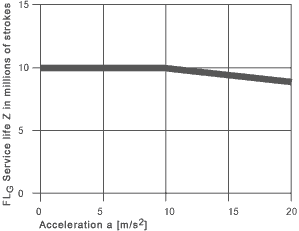
X = acceleration a [m/s2]
Y = FLG lifetime Z in million strokes n
Standard values on service life for FLG , (unsupported, sag), dependent on acceleration

X = acceleration a [m/s2]
Y = FLG lifetime Z in million strokes n
Standard values on service life for FLB , (unsupported, sag), dependent on acceleration
Unsupported E-Chains® normally require some type of surface on which the lower portion of the E-Chain® runs. A wide range of configurations is available, as the drawings on the right demonstrate. Many material options are feasible: Metals, polymers, stone, wood, concrete, glass, etc. We also have solutions to minimize the noise generated by the chain’s lower portion. Please consult igus®. When selecting the running surface, be sure dirt and debris cannot collect in the E-Chain® path.

Different surfaces + guide troughs are possible
We recommend pivoting mounting brackets as standard for unsupported applications. Pivoting mounting brackets compensate for the camber, can be installed more easily and decrease the load on the first E-Chain® link in operation. Exception: If the acceleration is greater than 20 m/s² or if the height is limited to the HF measurement, locking mounting brackets keep the E-Chain® under the HF measurement.
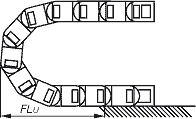
We recommend pivoting mounting brackets as standard! We recommend locking mounting brackets as standard if high speeds > 20 m/s or accelerations > 20 m/s²
E-Chains® without support along the lower run have restricted use. The value FLU usually must be determined in a test by igus®. The maximum permissible amount of the projection depends on the fill weight, the selected E-Chain®, the dynamics, and other factors, because the various combinations of these parameters can produce very different results. If the lower run of the E-Chain® cannot be supported over the whole travel, please consult igus®.
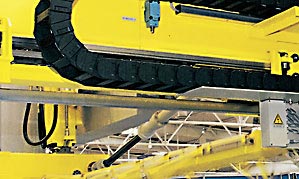
System E4 partially unsupported - please consult igus® regarding this type of configuration
More than 100,000 products available! Delivery and consultation Mon-Fri from 7am-8pm and Sat from 8am-12pm!